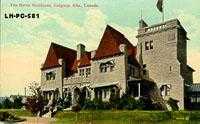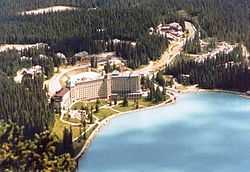Francis Rattenbury
| Francis Rattenbury | |
|---|---|
 Francis Mawson Rattenbury 1924 | |
| Born |
1867 Leeds England |
| Died | 1935 |
| Nationality | British |
| Buildings | Provincial Courthouse of British Columbia, which was renovate and is now known as the Vancouver Art Gallery |
Francis Mawson Rattenbury (1867–1935) was an architect born in England, although most of his career was spent in British Columbia, Canada, where he designed many notable buildings. Divorced amid scandal, he was murdered in England at the age of 68 by his second wife's lover.
Architectural career
Rattenbury was born in 1867 in Leeds, England. He began his architectural career with an apprenticeship in 1884 to the "Lockwood and Mawson Company" in England, where he worked until he left for Canada. In 1891, he arrived in Vancouver, in the new Canadian province of British Columbia.
The province, anxious to show its growing economic, social and political status, was engaged in an architectural competition to build a new legislative building in Victoria. The new immigrant entered, signing his drawings with the pseudonym "A B.C. Architect," and won the competition. Despite many problems, including going over-budget by $400,000, the British Columbia Parliament Buildings were officially opened in 1898.[1] The grand scale of its 500-foot (150 m)-long facade, central dome and two end pavilions, the richness of its white marble, and its use of the currently-popular Romanesque style contributed to its being seen as an impressive monument for the new province. Rattenbury's success in the competition garnered him many commissions in Victoria and other parts of the province, including additions to the Legislative Buildings in 1913–1915. In 1900 he was commissioned to design the 18 bedroom, three story Burns Manor in Calgary for his close friend Pat Burns.

He designed Paardeburg Gate (1901), a memorial to South African soldiers opposite the Legislative Buildings, 1901.[2]
Rattenbury also worked for the Canadian Pacific Railway as their Western Division Architect. His most well-known work for the CPR was The Empress (hotel), a Chateau-style hotel built in 1904–1908 in Victoria, with two wings added in 1909–1914. The architect, however, fell out with the CPR and went to work for their competition, the Grand Trunk Pacific Railway. He designed many hotels and stations for the GTP, but they were never completed due to the death of the president, Charles Melville Hays, in the sinking of the RMS Titanic and the company's subsequent bankruptcy. The CPR allowed him to return, however, and he built the second CPR Steamship Terminal in Victoria in 1923–1924 in association with another architect, Percy James. Rattenbury and James also collaborated in the design of the Crystal Garden at the same time, although they later had a public conflict over Rattenbury's refusal to give James credit and payment for his work on the Garden.
Just as quickly as he became popular, Rattenbury and his architecture was out of favour. Perhaps a symptom of his waning popularity, he lost the competition to build the Saskatchewan Legislative Building, built 1908–1912 in Regina, to E. and W.S. Maxwell, two Montreal architects trained at the École des Beaux-Arts in Paris. In contrast to the Maxwells, Rattenbury had no formal training in architecture and, with the increasing professionalism of the field, was soon outpaced by better-trained and better-educated architects.
Personal life
Soon after winning the competition for the Legislative Buildings in Victoria, Rattenbury was involved in a series of financial ventures. Most notably, he planned to supply meat and cattle to prospectors during the Klondike Gold Rush and he ordered three steam trains to serve the Yukon Territory. These investments eventually became profitable. After World War I, however, his luck turned sour with the failure of some financial speculations, eventually leading to conflicts with his business partners.
His personal life also began to show strains at this time. In 1923, he left his wife Florence Nunn, whom he had married in 1898, and his children, Frank and Mary, for the 27-year-old, twice-married Alma Pakenham. His maltreatment of Florence, which included having the heating and lights turned off in their home after he moved out, and the public flaunting of his affair with Alma, led his former clients and associates to shun him, forcing him to leave Victoria. He married Alma in 1925 after Florence agreed to his request for divorce. He and Alma returned to Victoria in 1927 with Christopher, her son from her second marriage. There, they had a son of their own, John, before deciding to move to Bournemouth, England, in 1929, the same year that Florence died.
Murder
In Bournemouth, Rattenbury's financial problems continued, causing his relationship with Alma to deteriorate. She began an affair with George Percy Stoner, their 18 year old chauffeur. Stoner had been recruited through an advertisement in the Bournemouth Daily Echo, and had been living a sheltered, largely friendless life with his parents before moving into the Rattenburys' home, the 'Villa Madeira', in Manor Road.
In the early hours of 23 March 1935, Rattenbury was discovered in his sitting room with severe head injuries. He had sustained a series of blows with a carpenter's mallet, the blows savage enough to remove the back of his skull; he died four days later. His wife confessed, but Stoner admitted to the housekeeper that it was actually he who had carried out the deed. Alma Rattenbury and Stoner were both charged, although Alma was to retract her confession after her elder son Christopher visited her in prison. Stoner was convicted and sentenced to death, later commuted to life imprisonment following the submission to the Home Secretary of a petition signed by over 300,000 people who felt that the young man had been manipulated into committing murder by the older woman. Alma was acquitted of murder and of being an accessory after the fact but committed suicide a few days later on 4 June 1935,[3] stabbing herself six times in the breast with a dagger before throwing herself into the River Stour, Dorset at Christchurch.[4][5]
Stoner served only seven years of his sentence, being released early in order to join the army and fight in the Second World War. He married in 1944, and fathered a daughter in 1948. He and his wife led "a quiet life" in the Bournemouth area, although he was to briefly attract the attention of the media again when he was given two years' probation for indecently assaulting a 12 year-old boy in a washroom in 1990.[6] It is possible Stoner was already suffering from Alzheimer's Disease at the time of the offence; he died aged 83 at Christchurch Hospital in 2000.[7][8]
The case report is studied by law students throughout the world where common law applies.
Despite Francis Rattenbury's outstanding career as an architect, he was buried in an unmarked grave, in a cemetery close to his home in Bournemouth. In 2007, 72 years later, a headstone was erected as a lasting memorial, paid for by a family friend.
Cultural references
In 1937, playwright and actor Emlyn Williams suggested to producer Alexander Korda the idea of making a film about "the Rattenbury murder case" with actors Laurence Olivier and Merle Oberon. Williams then joined Oberon in the cast of Korda's film I, Claudius instead.[9]
The case was the basis of the radio and stage play Cause Célèbre by Sir Terence Rattigan. A television play based on the case, "Killer In Close-Up: The Rattenbury Case", written by George F. Kerr, was produced by Melbourne television station ABV-2, airing on June 18, 1958. An Anglia television adaptation of the earlier Rattigan screenplay was shown on ITV on August 23, 1987.
Gallery of his work
| Building | Year Completed | Builder | Style | Location | Image |
|---|---|---|---|---|---|
| British Columbia Parliament Buildings home to the Legislative Assembly of British Columbia. | 1891–1898, additions 1913-1915 | Francis Rattenbury | Victoria, British Columbia | | |
| Empress Hotel | (1904–1908, additions in 1909 and 1914) | Francis Rattenbury | Victoria, British Columbia |  | |
| Canadian Pacific Railway Steamship Terminal, Victoria | 1924 | Francis Rattenbury | Victoria's Inner Harbour; Victoria, British Columbia | | |
| Burns Manor | 1903 | Francis Rattenbury | Calgary, Alberta |  | |
| Vancouver Art Gallery formerly Court House | (1905–1913, remodelled in 1983) | Francis Rattenbury | Vancouver, British Columbia |  | |
| Chateau Lake Louise | additions (1900–1912, burned down in 1924) | Thomas Sorby, Francis Rattenbury | Lake Louise, Banff, Alberta |  | |
| Mount Stephen House | additions (1900–1902, dismantled 1963) | Thomas Sorby, Francis Rattenbury | Tudor Revival | Field, British Columbia |  |
List of buildings
- Roedde House, Vancouver (1893)
- Nanaimo Court House, Nanaimo (1895)
- Bank of Montreal, Victoria (1896)
- Bank of Montreal, Rossland (1898)
- Bank of Montreal, Nelson (1899)
- Lieutenant Governor's Residence, Victoria (1901, destroyed by fire in 1957)
- Victoria High School (Fort Street location), Victoria (1901, demolished in 1953)
- Phoenix Hospital, Phoenix (1901, demolished)
- Burns manor (1903)
- Janet Clay House, Victoria (1904)
- Merchant's Bank, Victoria (1907)
- Court House, Nelson (Designed 1903, completed November 1908, supervising local architect, Alexander Carrie)
- Pacific Railway Steamship Terminal, Victoria (1923–1924)
- Crystal Garden, Victoria (1925)
- Merchants Bank, Nanaimo (1909–1911)
Notes
- ↑ Pound, Richard W. (2005). 'Fitzhenry and Whiteside Book of Canadian Facts and Dates'. Fitzhenry and Whiteside.
- ↑ http://www.dictionaryofarchitectsincanada.org/architects/view/1409 Francis Rattenbury
- ↑ http://news.google.com/newspapers?id=dLVIAAAAIBAJ&sjid=0QENAAAAIBAJ&pg=5895,2093625&dq=alma+rattenbury&hl=en FREED IN MURDER OF HER HUSBAND, SHE KILLS SELF - The Meriden Daily Journal: June 5, 1935
- ↑ http://news.google.com/newspapers?id=bVsvAAAAIBAJ&sjid=N9sFAAAAIBAJ&pg=1040,2307891&dq=alma+rattenbury&hl=en Mrs. A. Rattenbury Decided In Cells To Take Own Life: June 7, 1935
- ↑ Hodge, James H. (ed.), Famous Trials 5, Penguin, 1955, 221 (verdict), 223 (suicide)
- ↑ "Sex Attacker Sentenced", The Guardian, 29 September 1990, p. 2.
- ↑ York Membery, "Murder, suicide and the pain of a surviving son", The Times, 29 November 2007, p. 10.
- ↑ York Membery, "Killer's wife speaks out 67 years later: The Rattenbury Murder." National Post (Canada), 30 November 2002.
- ↑ Williams mentions this story in the 1965 BBC documentary The Epic That Never Was, about the making of the unfinished I, Claudius.
External links
- British Columbia Parliament Buildings
- The Empress Hotel
- Second Hotel Vancouver, Georgia & Granville, c.1920
- BC ARCHITECTS
- Fulford article, Globe & Mail 27 May, 1998
- Headstone at last for victim of 1930s murder The Daily Telegraph 19 November 2007
- Historic Places in Canada
Biography
- Reksten, Terry: Rattenbury Sono Nis Press, Victoria, British Columbia, (1998) ISBN 1-55039-090-2
- Barrett, Anthony A & Liscombe, Rhodri Windsor: Francis Rattenbury and British Columbia, Architecture and Challenge in the Imperial Age, University of British Columbia Press, Vancouver (1983) ISBN 0-7748-0178-6
| Wikimedia Commons has media related to Francis Rattenbury. |
|